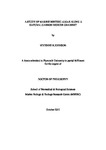A study of marine benthic algae along a natural carbon dioxide gradient
| dc.contributor.supervisor | Hall-Spencer, Jason | |
| dc.contributor.author | Johnson, Vivienne R | |
| dc.contributor.other | School of Biological and Marine Sciences | en_US |
| dc.date.accessioned | 2012-12-12T15:53:44Z | |
| dc.date.available | 2012-12-12T15:53:44Z | |
| dc.date.issued | 19/10/2012 | |
| dc.date.issued | 2012 | |
| dc.identifier | 772229 | en_US |
| dc.identifier.uri | http://hdl.handle.net/10026.1/1230 | |
| dc.description | Some chapters of this thesis were prepared as papers and have now been published: Johnson VR, Brownlee, C, Rickaby REM, Graziano M, Milazzo M & Hall-Spencer, JM (2012a) Responses of marine benthic microalgae to elevated CO2. Marine Biology, DOI: 10.1007/s00227-011-1840-2, Johnson VR, Russell BD, Fabricius KF, Brownlee C, Hall-Spencer JM (2012b). Temperate and tropical brown macroalgae thrive, despite decalcification, along natural CO2 gradients. Global Change Biology 18: 2792-2803. Some of the data within this thesis also contributes in part to the following publications: Lidbury I, Johnson VR, Hall-Spencer JM, Munn CB, Cunliffe M (2012) Community-level response of coastal microbial biofilms to ocean acidification in a natural carbon dioxide vent system. Marine Pollution Bulletin, DOI:10.1016/j.marpolbul.2012.02.011, Suggett DJ, Hall-Spencer JM, Rodolfo-Metalpa R, Boatman TG, Payton R, Pettay T, Johnson VR, Warner ME, Lawson T (2012) Sea anemones may thrive in a high CO2 world. Global Change Biology. DOI: 10.1111/j.1365-2486.2012.02767.x | en_US |
| dc.description.abstract |
Increasing atmospheric CO2 is causing unprecedented changes in seawater chemistry, yet the uncertainty of the ecological response to these projected changes, termed ‘ocean acidification’, remains considerable at present. To predict the effects of these changes, we need to improve our understanding of the responses of marine primary producers since these drive biogeochemical cycles and determine the structure and function of benthic habitats. The majority of experiments on the effects of ocean acidification on photoautrophs to date have mainly focused on oceanic microalgae, leaving benthic assemblages largely overlooked. Carbon dioxide vents are providing a means for examining and predicting the impacts of ocean acidification on marine ecosystems. In this thesis a temperate CO2 volcanic vent gradient was used to investigate the responses of benthic microalgal assemblages (periphyton, epilithic, epipelic, epipsammic and endolithic) and macroalgae (a calcified phaeophyte, crustose coralline algae and turf algae) to increasing pCO2. The photosynthetic standing crop of microphytobenthic assemblages increased significantly with elevations in CO2 indicating that the productivity of shallow water habitats may be promoted over the course of this century. Some benthic diatoms appear to benefit in naturally CO2 enriched environments whilst benthic cyanobacteria in this study appear to be relatively insensitive to the levels of increase predicted for this century. Dramatic shifts in epilithic macroalgae assemblages were observed along the CO2 gradient and a calcified phaeophyte was revealed as an unexpected ecological winner under ocean acidification scenarios. These observations suggest that benthic algal assemblages have the potential to dramatically alter as CO2 levels continue to rise; this would have profound consequences for the structure and function of benthic ecosystems. | en_US |
| dc.language.iso | en | en_US |
| dc.publisher | University of Plymouth | en_US |
| dc.subject | Ocean Acidification | en_US |
| dc.subject | Microphytobenthic Assemblages | en_US |
| dc.subject | Carbon dioxide | en_US |
| dc.subject | Macroalgae | en_US |
| dc.title | A study of marine benthic algae along a natural carbon dioxide gradient | en_US |
| dc.type | Thesis | |
| plymouth.version | Full version | en_US |
| dc.identifier.doi | http://dx.doi.org/10.24382/4433 |
Files in this item
This item appears in the following Collection(s)
-
01 Research Theses Main Collection
Research Theses Main


